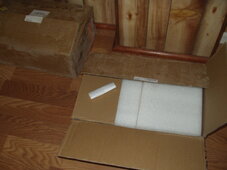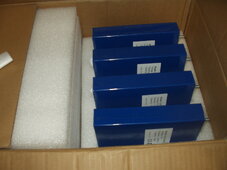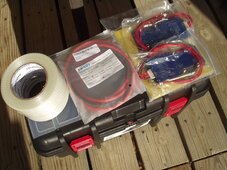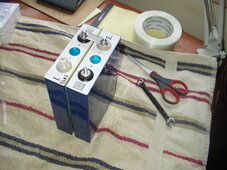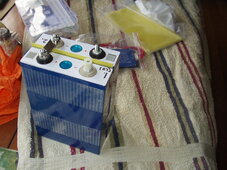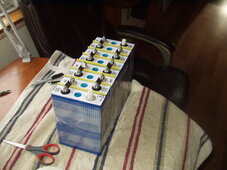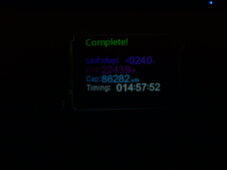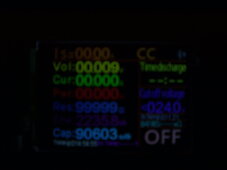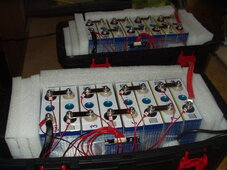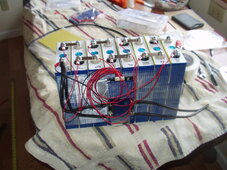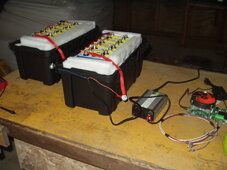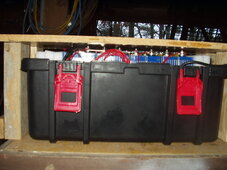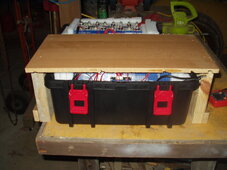Battery from scratch.
This is my first ever attempt to build a workable, cheap as possible, LiFePO4 24vDC using 105ah battery cells.
The cells and BMS were bought on Aliexpress with some items coming from Amazon (tape, battery separators, terminal connectors and 8 awg soft silicone wire) plus the tool boxes were from Walmart. On Singles day (11/11) sale from Aliexpress I bought and had shipped 16 Liitokala 105ah LiFePO4 cells. They took until 12/19 to arrive. I also bought 2 BMS’s of 8S 100a configuration at ~$22 ea. The price on the batteries with all the discounts was ~$480/16 or about $30 a piece. The items from Amazon added up to ~ $85, and the 2 tool boxes were ~$27 from Walmart. All told I have ~$650.00.
I did a voltage check on each cell so that during assembly I could match comparable ones together for each battery. 15 of them were real close ranged from 3.296vDC to 3.300vD (mostly 3.298vDC therefore 70% SOC) however there is one low voltage cell at 3.265vDC or about 50% SOC. It will bear watching. I numbered as #1 for record keeping sake.
Construction consisted of taping each two cells together with a separator. The separators I bought had to be cut down slightly for the cell size. At this point 4 double packs with separators taped together was than placed in the tool box for fit. I found that I unfortunately I had to remove the locking tool box top due to battery height, including the terminal rods, was greater than anticipated by the specs given for the battery. Without those bolts it would have fit. Plenty of side space to put all components plus padding. Battery packs was taken out of box for final assembly.
The BMS balance leads were fitted with terminal connectors, plus numbered, and the double 8 awg power leads with connectors were added as well. As an aside, real fine flexible wire is a pain to fit with connectors. Darn strands want to splay out. All the busbars were connected, tightened with the BMS leads connected. The BMS was taped with nylon spacers between it and the cells with the temperature probe downward. At this point it was back in the box and I used the foam shipping to pad the sides.
Below are images of the parts and build.
{Continued on next post}
This is my first ever attempt to build a workable, cheap as possible, LiFePO4 24vDC using 105ah battery cells.
The cells and BMS were bought on Aliexpress with some items coming from Amazon (tape, battery separators, terminal connectors and 8 awg soft silicone wire) plus the tool boxes were from Walmart. On Singles day (11/11) sale from Aliexpress I bought and had shipped 16 Liitokala 105ah LiFePO4 cells. They took until 12/19 to arrive. I also bought 2 BMS’s of 8S 100a configuration at ~$22 ea. The price on the batteries with all the discounts was ~$480/16 or about $30 a piece. The items from Amazon added up to ~ $85, and the 2 tool boxes were ~$27 from Walmart. All told I have ~$650.00.
I did a voltage check on each cell so that during assembly I could match comparable ones together for each battery. 15 of them were real close ranged from 3.296vDC to 3.300vD (mostly 3.298vDC therefore 70% SOC) however there is one low voltage cell at 3.265vDC or about 50% SOC. It will bear watching. I numbered as #1 for record keeping sake.
Construction consisted of taping each two cells together with a separator. The separators I bought had to be cut down slightly for the cell size. At this point 4 double packs with separators taped together was than placed in the tool box for fit. I found that I unfortunately I had to remove the locking tool box top due to battery height, including the terminal rods, was greater than anticipated by the specs given for the battery. Without those bolts it would have fit. Plenty of side space to put all components plus padding. Battery packs was taken out of box for final assembly.
The BMS balance leads were fitted with terminal connectors, plus numbered, and the double 8 awg power leads with connectors were added as well. As an aside, real fine flexible wire is a pain to fit with connectors. Darn strands want to splay out. All the busbars were connected, tightened with the BMS leads connected. The BMS was taped with nylon spacers between it and the cells with the temperature probe downward. At this point it was back in the box and I used the foam shipping to pad the sides.
Below are images of the parts and build.
{Continued on next post}



